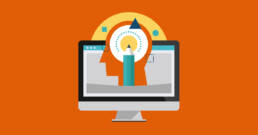
Don’t Overlook Psychology in Your Web Design

February 9, 2021
share this post
Mouse overs and hover states. Kerning and cap heights. Fonts and colors. Shapes and patterns. Breadcrumbs and favicons. Monochromatic and complementary.
On the surface, the endless elements of web design involve only art and technology, yet behind the scenes lurks a critical field of study: psychology.
Today, psychology encompasses the overarching study of the human mind, with branches and offshoots in subfields like behavioral, social, developmental, cognitive, and organizational psychology, along with the learning and brain sciences (including neuroscience). What parts matter most in web design?
The honest answer: all of them. But that doesn’t mean you need a web designer with doctorate degrees in every facet of psychology. Instead, you need a team who can understand your user groups – their pain points, provocations, and cognitive capabilities as humans of a particular age, education level, and demographic – and apply what they learn, along with the principles of psychology, to the design and development process.
Although our team can talk endlessly about the importance of usability testing, this month, we want to focus on an overlooked but essential part of usability and web design – psychology – starting with three psychological principles that influence our process.
1. Conventions are our friends.
Plenty of companies and organizations want a website that breaks new ground and comes across as innovative, believing it will send the message that their work is bold and, perhaps, disruptive. In reality, thinking too intensively outside the box in your web design can come with unintended consequences: confusion and frustration.
This is where the principle of convention comes into play, reminding us that users are human, and humans are hardwired for habits and routines. “As the proverbial creatures of habit, people tend to repeat the same behaviors in recurring contexts,” explain psychology professors Wendy Wood and Dennis Rünger in a 2016 study, “Psychology of Habit.” With routine tasks like cooking breakfast or doing the laundry, acting habitually means acting efficiently – and preserving our limited supply of cognitive resources for other steps and decisions, Wood and Rünger say.
When exploring websites, whether on a smartphone, tablet, laptop, or desktop, users expect consistency with navigational features and pathways – and tend to act habitually as they click through your site. They expect to find your navigation menu up top and general information about your organization in the footer. They want to see your logo in the upper-left corner; links handled consistently across your site; and clear naming conventions for sections like Careers and Services. While there are plenty of ways to convey your creative prowess in your site, overhauling basic website conventions isn’t one of them.
2. Option overload overwhelms.
Most of us view choice as a positive. But in reality, too much choice can overwhelm us, leaving us paralyzed to make or act on a decision. “As the number of choices we face increases, freedom of choice eventually becomes a tyranny of choice,” writes Swarthmore University psychology professor Barry Swartz in his acclaimed book, The Paradox of Choice: Why Less Is More.
Swartz gives examples from his life to which many of us relate. When he ventures to the mall to buy blue jeans, his simple excursion turns into an elaborate tutorial on slim fit vs. relaxed fit, button fly vs. zipper fly, and two-tone vs. stone washing. What does he eventually realize? His new, relaxed fit jeans feel better (the upside of options), but he feels worse (the downside of options). Thus, he finds himself in the “tyranny of choice.”
“Choice overload can make you question the decisions you make before you even make them,” Swartz writes. “It can set you up for unrealistically high expectations, and it can make you blame yourself for any and all failures. In the long-run, it can lead to decision-making paralysis.”
In web design, the same lesson applies: less is often more. Other scientists back up the finding, including the British experimental psychologist William Hick, who found that the time it takes to make a decision increases with the number and complexity of options. Designers refer to his finding as Hick’s Law and use it as a reminder to streamline navigation and purchase options, while avoiding things like pop-ups and sign-up opportunities.
The takeaway? Streamline what you want to communicate. Don’t overload users with too many options.
3. Curiosity drives engagement.
As humans, we are primed to seek information – and to fill gaps in our understanding with, well, more information. George Loewenstein, Director of the Center for Behavioral Decision Research at Carnegie Mellon University, refers to this as the “information-gap theory” and believes it explains our natural inclination toward curiosity and our innate urge to learn and discover.
Curiosity is “a cognitive induced deprivation that arises from the perception of a gap in knowledge and understanding,” Loewenstein writes in “The Psychology of Curiosity,” a study from Psychological Bulletin. As such, curiosity influences behavior – and can be harnessed to engage users and entice them to learn more. How?
Although some clients want to feature every single thing imaginable on their websites, we advise a more strategic approach in what to include and exclude. Say, for example, that in an effort to attract investors, you create an animation to showcase the novel medical treatment you spent a decade developing. One approach would be to reveal everything. But a wiser, more calculated approach would be to use your animation to pique investors’ interest and make them want to know more. Perhaps your animation lures them to sign up for a webinar or evening event where you can pitch your work in person, or perhaps they leave their email address so they can access an additional piece of content. Whatever the case, your animation baits their interest and sets you on a path toward a meaningful, fruitful relationship.
As you develop your website or search for the right web design partner, keep these three psychological principles in mind – and know that many others influence the process of creating an effective, engaging design.
Want to learn more about what Astriata can offer you? View our range of creative agency services, tailored to your organization’s unique business objectives and needs.